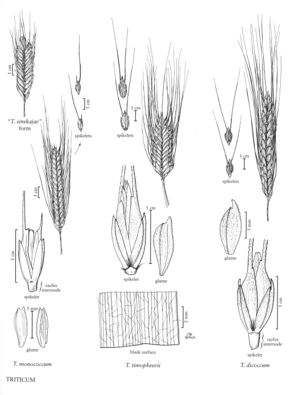Triticum dicoccum
Culms 80-150 cm, decumbent; nodes glabrous or pubescent; internodes mostly hollow, solid for 1 cm below the spikes. Blades to 20 mm wide, pubescent. Spikes 5-10 cm, about as wide as thick to wider than thick, cylindrical to strongly flattened; rachises glabrous or shortly ciliate at the nodes and margins; internodes (0.5)2-5 mm, disarticulating with pressure, dispersal units wedge-shaped. Spikelets 10-16 mm, elliptical to ovate, with 3-4 florets, usually only the lower 2 seed-forming. Glumes 6-10 mm, coriaceous, tightly appressed to the lower florets, with 1 prominent keel, keel winged only in the distal 2/3 terminating in a tooth; lemmas 9-12 mm, awned, lower 2 lemmas awned, awns to 17 cm, upper lemmas unawned or shortly awned; paleas not splitting at maturity. Endosperm flinty. Haplomes AUB. 2n = 28.
Discussion
Triticum dicoccum is the domesticated derivative of T. dicoccoides. It was once grown fairly extensively in central and southern Europe, southern Russia, northern Africa, and Arabia, because it can withstand poor, waterlogged soils. It is rarely grown now. It was introduced to the Flora region as a feed grain and forage for livestock. Currently, its primary use in the region is for plant breeding; it is also sold for human consumption as farro in specialty food markets.
Selected References
None.
